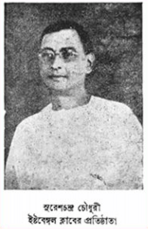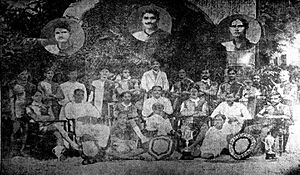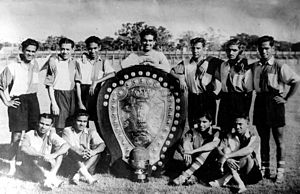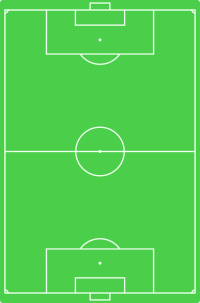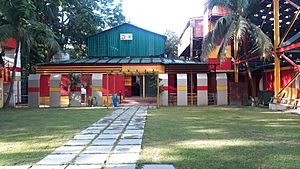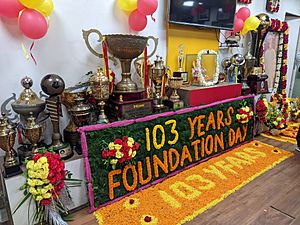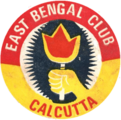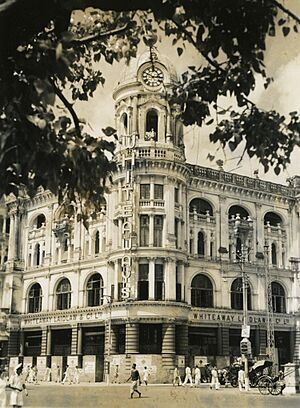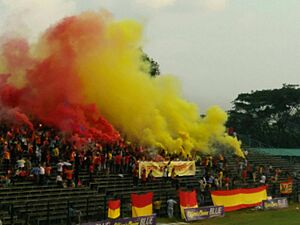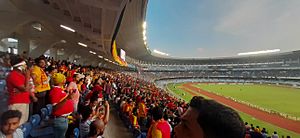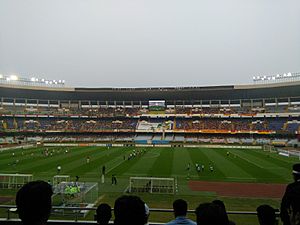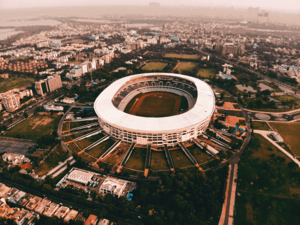East Bengal FC facts for kids
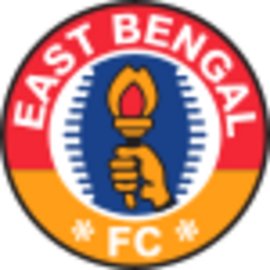 |
|||
| Full name | East Bengal Football Club | ||
|---|---|---|---|
| Nickname(s) | Red& Gold brigade bagh Torch bearer Mariners |
||
| Short name | EBFC | ||
| Founded | 21 August 2020 | ||
| Stadium | Salt Lake Stadium East Bengal Ground |
||
| Stadium capacity |
68,000 23,500 |
||
| Owner | Emami East Bengal FC Pvt. Ltd.:
|
||
| President | Murari Lal Lohia | ||
| Head coach | Óscar Bruzón | ||
| League | Indian Super League | ||
| 2021–22 | Indian Super League, 11th of 11 Playoffs: DNQ |
||
|
|
|||
Emami East Bengal FC, often called East Bengal, is a professional football club from Kolkata, West Bengal, India. They play in the Indian Super League, which is the top football league in India. East Bengal is one of India's most successful clubs, having won many titles. They have won three national league titles and a record 40 state league titles. The club has also won important cup competitions like the Federation Cup and Super Cup. This makes them one of the most decorated football clubs in India.
East Bengal is one of the three biggest clubs in Kolkata. They play in the famous Kolkata Derby against their rivals Mohun Bagan. They also have a smaller rivalry, the mini Kolkata derby, with Mohammedan.
The club was started in August 1920. They joined the Indian Football Association in 1922. East Bengal first played in the Calcutta Football League Second Division. They moved up to the First Division in 1924. East Bengal won their first First Division league title in 1942. They have won it a record 40 times since then. The club was also a founding member of the National Football League in 1996. They have won this league three times. East Bengal has also won nine national cup titles. This includes the Federation Cup eight times and the Super Cup once. They have won many other trophies too, like the Durand Cup 16 times and the IFA Shield a record 29 times. East Bengal also won an international friendly trophy, the ASEAN Club Championship.
Contents
Club History
How the Club Started
On July 28, 1920, a football match was planned between Jorabagan and Mohun Bagan. A player named Sailesh Bose was left out of the Jorabagan team. Suresh Chandra Chaudhuri, a vice-president of Jorabagan, wanted Bose to play. When his request was not accepted, Chaudhuri left the club. He was joined by Raja Manmatha Nath Chaudhuri, Ramesh Chandra Sen, and Aurobinda Ghosh.
They decided to form a new club called East Bengal. This happened on August 1, 1920, in the Jorabagan area. The name East Bengal was chosen because the founders came from the eastern part of Bengal. Sarada Ranjan Ray became the first president of the new club. Suresh Chandra Chowdhury and Tarit Bhusan Roy were the first joint secretaries. Soon, the first team squad was announced with many talented players.
Early Years: 1920s–1930s
In August 1920, East Bengal played its first tournament, the Hercules Cup. This was a seven-a-side tournament. On August 11, 1920, they played their first match ever against Metropolitan College and won 4–0. East Bengal went on to win the tournament. This showed that a new strong club had arrived. They also won the Khagendra Shield in 1921.
After this, the club joined the Indian Football Association (IFA). They entered the IFA Second Division. In their first season, they finished third. The first unofficial match between East Bengal and Mohun Bagan was on August 8, 1921. It was a semi-final match in the Cooch Behar Cup and ended in a draw.
In 1924, East Bengal won the Second Division. They were promoted to the IFA First Division. At that time, the IFA, which was a British organization, only allowed two Indian clubs in the First Division. This rule had stopped other Indian clubs from joining. However, nine British clubs in the IFA voted to allow East Bengal's promotion. Interestingly, the two Indian clubs, Mohun Bagan and Aryan, were against it. East Bengal's efforts helped to remove this unfair rule.
East Bengal played its first IFA First Division match in 1925. Mona Dutta scored the club's first goal in the league. The first official Kolkata Derby was played on May 28, 1925. Nepal Chakraborty scored the only goal for East Bengal in that match.
Golden Decades: 1940s–1970s
It took until 1942 for the club to win its first IFA First Division title. East Bengal won their first IFA Shield in 1943. In 1945, they won both the Calcutta Football League (CFL) and the IFA Shield. In 1948, East Bengal became the first Indian team to beat a foreign club on home ground. They won 2–0 against the Chinese Olympic XI.
In 1949, East Bengal won their first treble. This means they won three major trophies in one season: the Calcutta League, the IFA Shield, and the Rovers Cup. They were the first Indian club to do this. This period saw the rise of the Pancha Pandavas. These five players, P. B. A. Saleh, Ahmed Khan, P. Venkatesh, Appa Rao, and K. P. Dhanaraj, played together from 1949 to 1953. The club also won its first DCM Trophy in 1950. They won the IFA Shield three years in a row: 1949, 1950, and 1951.
The English Football Association's 1951–52 almanac called East Bengal the best club in Asia. In 1953, the club was invited to a tournament in Romania. They also toured the Soviet Union that same year. East Bengal won the Rovers Cup many times in this era. They also won the Durand Cup several times. In 1968, they won their first Sait Nagjee football tournament and Bordoloi Trophy.
In 1970, the club won the IFA Shield against PAS Club from Iran with a score of 1–0. This match was played in front of 60,000 fans at the Eden Gardens. Later, in 1973, they won the IFA Shield again by beating Pyongyang City SC from North Korea. In 1978, East Bengal won its first Federation Cup title.
East Bengal won the Calcutta Football League for six years in a row, from 1970 to 1975. In 1970, they won the league without letting in a single goal. East Bengal also won many times against their rivals, Mohun Bagan. This included a record 5–0 win in the Kolkata Derby in 1975. The 1970s are known as the "Shonali Doshok" (Golden Decade) for the club.
1980s–1990s
The club won the Federation Cup in 1980 and again in 1985. They were also the first Indian club to play in the new Asian Club Championship in 1985–86. In 1990, under coach Naeemuddin, the club won their second treble. They won the IFA Shield, the Rovers Cup, and the Durand Cup in the same season. In 1993, East Bengal won its first international title, the Wai Wai Cup in Nepal.
In 1996, the club became a founding member of India's first nationwide football league, the National Football League. In 1984, Dipak Das joined the club and helped it become more professional. He turned the football team into a private company. In 1998, the club partnered with Vijay Mallya's United Breweries Group. They formed a new company called Kingfisher East Bengal FC. This was the first time an Indian football team was set up this way.
2000s–2010s
East Bengal started the 21st century strongly. They won the 2000–01 National Football League season. They were the first club to win back-to-back titles in 2002–03 and 2003–04. The club won the Federation Cup again in 2007, 2009, 2010, and 2012. They also won the Indian Super Cup in 2006 and 2011.
In 2003, the club won its third international trophy, the 2003 ASEAN Club Championship, in Jakarta, Indonesia. East Bengal is still the only Indian football team to win a major trophy outside the country. In 2004, East Bengal also won the San Miguel International Cup in Nepal. The club was invited to this tournament by Leicester City.
FIFA president, Joseph Blatter, visited the club on April 15, 2007. A year later, East Bengal became the first Indian football team to win against a West Asian team, Al Wihdat SC of Jordan, on their home ground. East Bengal also played in the AFC Cup eight times between 2004 and 2015. They reached the semi-finals of the 2013 AFC Cup.
The club holds a record for winning the Calcutta Football League title eight times in a row, from 2010 to 2017. This broke their own record of six consecutive wins in the 1970s. After Kingfisher left the club, Quess Corp became the main investor in July 2018. The football team was then called Quess East Bengal FC.
On August 1, 2019, the club celebrated its 100th year. A special logo was created for the centenary. Events and torch rallies were held, attended by former players and coaches. The centenary kit, inspired by the 1925–26 season kit, was also revealed. The club played in the Durand Cup, the Calcutta Football League, and the I-League.
Recent Years: 2020–Present
In 2020, the COVID-19 pandemic stopped the football season in India. The investor, Quess, left the club by July 2020. On August 1, the club completed 100 years of its existence. In September, Shree Cement became the new investor. They bought 76 percent of the club's shares. The club's name changed to "Sporting Club East Bengal". Later that month, the club moved from the I-League to the Indian Super League. In early 2022, the club and Shree Cement ended their partnership.
Shree Cement returned the club's sporting rights on April 12, 2022. This happened because they could not agree on a final contract. However, the club said they would continue to play in the Indian Super League. They also announced they would find new investors soon. East Bengal faced another transfer ban from AIFF for not paying some players.
On May 25, 2022, East Bengal announced that Emami would be their main investors. The club confirmed they would play in the 2022-23 Indian Super League season with the new investors. On July 18, after two months of talks, the club started signing new players. On July 22, the AIFF lifted the transfer ban on East Bengal.
East Bengal appointed Santosh Trophy winning coach Bino George as the caretaker head coach for the Calcutta Football League and Durand Cup. He would then become the assistant coach for the Indian Super League. The club also hired former India national football team coach Stephen Constantine as the new head coach. The formal partnership with Emami was also announced.
Emami East Bengal FC later hired Carles Cuadrat as their new head coach for two years. On January 28, 2024, they beat the defending champions Odisha 3–2 in the Kalinga Super Cup final. This was their first title in 12 years. They also qualified for the AFC Champions League 2 play-offs. As winners, East Bengal entered the 2024–25 AFC Champions League Two preliminary stage but lost to FC Altyn Asyr.
Club Identity
Club Crest
In 1930, Mahatma Gandhi's Satyagraha movement affected football in India. Indian clubs stopped playing in the Calcutta Football League. East Bengal was not allowed to be promoted to the First Division. Thousands of East Bengal fans and officials protested at the East Bengal Ground. During this protest, people carried flaming torches. Because of this, a hand holding a flame torch became the club's emblem. This emblem is still used today. In 2020, East Bengal released a special crest to celebrate 100 years of the club.
Club Colours
East Bengal's main colours are red and yellow. Their home kit usually has a red and yellow jersey with black shorts. The away kit colours change each year. The founders chose these colours after the club was formed. They found a red and gold shirt at the Whiteaway, Laidlaw & Co. department store in Chowringhee, Kolkata. They liked the colours and decided to use them for the club's jersey. It cost ₹80 in 1920, which was quite expensive then. These colours have been a part of the club ever since.
|
|
Kit Sponsors
| Period | Kit manufacturer | Shirt sponsor | Back sponsor | Chest sponsor | Sleeve sponsor |
|---|---|---|---|---|---|
| 1993–94 | Verona | ||||
| 1994–95 | McDowell's No.1 | ||||
| 1995–96 | Emami | ||||
| 1996–97 | Umbro | ||||
| 1997–98 | Duta Sports | Khadim's | |||
| 1998–00 | Adidas | Kingfisher | |||
| 2000–05 | Reebok | ||||
| 2005–06 | Pony | ||||
| 2006–09 | Reebok | ||||
| 2009–10 | ONGC | ||||
| 2010–11 | Saradha | ||||
| 2011–14 | Sahara | Rose Valley | |||
| 2014–15 | Shiv Naresh | Artage | Artage | ||
| 2015–16 | SRMB | ||||
| 2016–17 | Officer's Choice Blue | ||||
| 2017–18 | Perf | Shyam Steel | |||
| 2018–19 | Quess | ||||
| 2019–20 | Kaizen Sports | ||||
| 2020–21 | TYKA | Shree Cement | TV9 Bangla | TopTech | |
| 2021–22 | Reyaur | ||||
| 2022–23 | Trak-Only | 1XBat | Mantra Masala | Emami | Alliance Broadband |
| 2023–24 | Batery | BoroPlus | |||
| 2024–25 | |||||
Club Supporters
East Bengal is mainly supported by people who moved from the eastern part of Bengal, known as Bangals. The club has about 30 to 40 million supporters across India and other countries. In October 2020, East Bengal was voted the most popular football club in India in an AFC poll. They received about 49% of the votes.
East Bengal Ultras is the main supporters' group for East Bengal. It was started in 2013 and was the first ultras group in India. This group has achieved many new things. Even though some people were unsure about the group at first, they now see how it helps Indian football. However, there have been some arguments and bad behavior among fans of rival clubs in the past. Because of this, the club's management does not fully trust the group's actions.
East Bengal the Real Power is India's first registered fan club. It was started on November 15, 2006. It is the largest fan club for East Bengal and one of the biggest in the country. In its early days, it was mostly an online group. Later, it became a full supporters' group.
Club Rivalries
Kolkata Derby
East Bengal has its biggest rivalry with Mohun Bagan. The matches between these two clubs are called the Kolkata Derby. This derby is similar to the Old Firm Derby between Celtic and Rangers because of its social and economic importance. It is one of the oldest rivalries in world sports, going back to the 1920s.
These clubs are rivals because they have competed fiercely in Indian football for over a hundred years. Both are the two most successful clubs in India. After India became independent, the second partition of Bengal caused many Bengali people to move from the eastern part of Bengal to other states. This led to social and economic challenges. It also created rivalries in jobs, businesses, schools, and even on the football field between the new arrivals and the local people.
This rivalry became very strong, and the Kolkata Derby grew in popularity, reaching its peak in the 1960s and 1970s. Bengalis living all over India and the world would watch this event. It was a way for them to connect with their culture after the partition. The Kolkata Derby regularly attracts over 60,000 spectators for each match. It is one of the most watched sports events in India. Fans of both clubs show great love for their teams through chants and large displays called tifos. The Kolkata Derby holds a record of 130,000 spectators, which is the most attended sports event ever in India.
Mini Derby
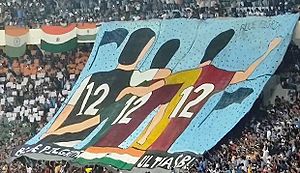
East Bengal also has an important rivalry with Mohammedan. This rivalry started in the early 1930s. Mohammedan became a strong team in the Calcutta Football League, winning seven out of eight titles from 1934 to 1941. From then until 1958, all CFL titles were won by these three rival clubs. They are often called the Big Three of Maidan (Bengali: ময়দানের তিন প্রধান). They also competed against each other in other major tournaments like the Durand Cup, Rover's Cup, and IFA Shield.
The rivalry first had a religious background. Mohammedan was a club mainly for Muslim people, representing the Muslim population of Kolkata. This led to Hindus in the city supporting Mohun Bagan and East Bengal. By the 1960s, the religious tension in the rivalry became less important. Mohammedan started signing non-Muslim players. However, the club also lost its strong position in Indian football. After national tournaments like the Federation Cup and National Football League began, Mohammedan was no longer a top club. They mostly played in lower leagues. So, they rarely met Mohun Bagan and East Bengal in major tournaments. Mohammedan won the I-league in the 2023–24 season and was promoted to the ISL. Unlike the fierce East Bengal-Mohun Bagan rivalry, matches involving Mohammedan and Mohun Bagan or East Bengal are called the Mini Kolkata Derby.
Club Ownership
East Bengal is set up as a registered society. This means people can become members of the club. There are about 12,000 members. A limited company called East Bengal Club Pvt. Ltd. was also formed. Both the society and the company work together to run the club. Sponsorships and investments come through this company. The club has its own rules and regulations. Changes to these rules are made at special meetings.
Currently, the football rights belong to a new company, Emami East Bengal FC Pvt. Ltd. This company is owned by both East Bengal and Emami Group. Emami Group owns 87% of the club.
Club Stadiums
The club has used several stadiums in Kolkata, Howrah, and Barasat. This includes the Eden Gardens, which is now used only for cricket since Salt Lake Stadium opened in 1984. The first ground the club used was Kumartuli Park in north Kolkata.
Salt Lake Stadium
The Salt Lake Stadium, also known as Vivekananda Yuba Bharati Krirangan (VYBK), is a large stadium in Kolkata. It was built in 1984. Most of East Bengal's home games are played here. The stadium used to hold 85,000 people, but its capacity was changed to 68,000.
East Bengal Ground
The East Bengal Ground is in Kolkata and is the club's historic home. It is located in the Maidan (Kolkata) area, near Fort William and the Eden Gardens. This stadium is mainly used for Calcutta Football League matches. It is also used by the club's academy, women's, and hockey teams. The stadium can hold 23,500 people.
Other Grounds
Barasat Stadium is sometimes used by the club for regional matches. This happens when Salt Lake Stadium or East Bengal Ground cannot be used. Kanchenjunga Stadium in Siliguri has also hosted club football matches. It hosted the 2012 Federation Cup. Kalyani Stadium, located near Kolkata in Kalyani, was East Bengal's home ground during the 2019–20 I-League season.
The team also trains at one of the practice grounds at VYBK.
Club Players
Current Squad
|
|
Players from Reserve Squad
|
Club Personnel
Current Technical Staff
Club Management
| Role | Name |
|---|---|
| President | |
| Chief advisor | |
| Vice-presidents | |
| General secretary | |
| Assistant general secretary | |
| Finance secretary | |
| Treasurer | |
| Football secretary | |
| Cricket secretary | |
| Hockey secretary | |
| Athletic secretary | |
| Tennis secretary | |
| Ground secretary | |
| Executive committee members |
Club Records
Indian Super League Performance
East Bengal FC league record by opponent
NFL/I-League Performance
East Bengal FC league record by opponent
Asian Competitions
| Competition | Appearances | Seasons | Best result |
|---|---|---|---|
| Asian Club Championship | 2 | 1985–86, 1998–99 | Group stage |
| Asian Cup Winners' Cup | 5 | 1991–92, 1993–94, 1994–95, 1995, 1997–98 | Quarter-finals (1991-92) |
| AFC Cup/AFC Champions League Two | 9 | 2004, 2005, 2008, 2010, 2011, 2012, 2013, 2015, 2024–25 | Semi-finals (2013) |
| AFC Challenge League | 1 | 2024–25 | Quarter-finals (2024-25) |
Club Honours
East Bengal Club has won many trophies both in India and internationally. They have won the National Football League title 3 times and the Federation Cup 8 times. They also won the Calcutta Football League a record 40 times and the IFA Shield a record 29 times. The club has won over 150 trophies in total.
- Record
- S Shared record
| Type | Tournament | No. | Years | Ref. | |
|---|---|---|---|---|---|
|
AFC Central Asia Qualifier
|
|||||
| AFC |
1
|
1985 | |||
|
International Tournaments
|
|||||
| AFF |
1S
|
2003 | |||
|
Domestic (Major)
|
|||||
|
3
|
2000–01, 2002–03, 2003–04 | ||||
|
9
|
1978, 1980, 1985, 1996, 2007, 2009–10, 2010, 2012, 2024 | ||||
|
3
|
1997, 2006, 2011 | ||||
|
40
|
1942, 1945, 1946, 1949, 1950, 1952, 1961, 1966, 1970, 1971, 1972, 1973, 1974, 1975, 1977, 1982, 1985, 1987, 1988, 1989, 1991, 1993, 1995, 1996, 1998, 1999, 2000, 2002, 2003, 2004, 2006, 2010, 2011, 2012, 2013, 2014, 2015, 2016, 2017, 2024 | ||||
|
29
|
1943, 1945, 1949, 1950, 1951, 1958, 1961, 1965, 1966, 1970, 1972, 1973, 1974, 1975, 1976, 1981, 1983, 1984, 1986, 1990, 1991, 1994, 1995, 1997, 2000, 2001, 2002–03, 2012 | ||||
|
16
|
1951, 1952, 1956, 1960, 1967, 1970, 1972,1978, 1982, 1989, 1990, 1991, 1993, 1995, 2002, 2004 | ||||
|
10
|
1949, 1962, 1967, 1969,1972. 1973, 1975, 1980, 1990, 1994 | ||||
| Total | 110 | ||||
|
Domestic (Minor and Other Trophies)
|
|||||
|
7
|
1950, 1952, 1957, 1960, 1973, 1974, 1983 | ||||
|
5
|
1968, 1972, 1973, 1978, 1992 | ||||
|
7
|
1987, 1988, 1990, 1992, 1995, 1998, 2001 | ||||
|
5
|
1976, 1981, 1982, 1985, 2018 | ||||
|
3
|
1995, 1997, 2000 | ||||
|
2
|
1968, 1986 | ||||
|
2
|
1981, 1986 | ||||
|
1
|
1984 | ||||
|
1
|
1993 | ||||
|
2
|
1989, 1991 | ||||
|
1
|
2002 | ||||
|
2
|
1957, 1961 | ||||
|
1
|
1992 | ||||
|
1
|
1956 | ||||
|
1
|
1968 | ||||
|
1
|
2010 | ||||
|
1
|
1920 | ||||
|
1
|
1921 | ||||
|
1
|
1920 | ||||
|
1
|
1921 | ||||
|
5
|
1924, 1942, 1943, 1945, 1960 | ||||
|
4
|
1960, 1966, 1975, 1976 | ||||
|
1
|
1929 | ||||
|
2
|
1929, 1946 | ||||
|
1
|
1940 | ||||
|
3
|
1920, 1968, 1969 | ||||
|
1
|
1938 | ||||
|
1
|
1947 | ||||
|
2
|
1969, 1976 | ||||
|
1
|
1942 | ||||
|
1
|
1960 | ||||
|
1
|
2023 | ||||
|
1
|
2023 | ||||
| Total | 70 | ||||
| All Total | 184m | ||||
- m Including minor trophies
Affiliated Clubs
The following club was formerly connected with East Bengal:
The following club is currently connected with East Bengal:
See also
 In Spanish: East Bengal Football Club para niños
In Spanish: East Bengal Football Club para niños
- East Bengal in international football
- East Bengal league record by opponent
- List of East Bengal matches against Foreign teams
- List of foreign players for East Bengal
- List of East Bengal records and statistics
- Indian football clubs in Asian competitions


